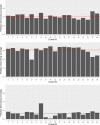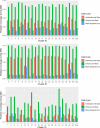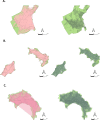Overestimation of school-based deworming coverage resulting from school-based reporting
- PMID: 37036890
- PMCID: PMC10118084
- DOI: 10.1371/journal.pntd.0010401
Overestimation of school-based deworming coverage resulting from school-based reporting
Abstract
Background: Soil Transmitted Helminths (STH) infect over 1.5 billion people globally and are associated with anemia and stunting, resulting in an annual toll of 1.9 million Disability-Adjusted Life Years (DALYs). School-based deworming (SBD), via mass drug administration (MDA) campaigns with albendazole or mebendazole, has been recommended by the World Health Organization to reduce levels of morbidity due to STH in endemic areas. DeWorm3 is a cluster-randomized trial, conducted in three study sites in Benin, India, and Malawi, designed to assess the feasibility of interrupting STH transmission with community-wide MDA as a potential strategy to replace SBD. This analysis examines data from the DeWorm3 trial to quantify discrepancies between school-level reporting of SBD and gold standard individual-level survey reporting of SBD.
Methodology/principal findings: Population-weighted averages of school-level SBD calculated at the cluster level were compared to aggregated individual-level SBD estimates to produce a Mean Squared Error (MSE) estimate for each study site. In order to estimate individual-level SBD coverage, these MSE values were applied to SBD estimates from the control arm of the DeWorm3 trial, where only school-level reporting of SBD coverage had been collected. In each study site, SBD coverage in the school-level datasets was substantially higher than that obtained from individual-level datasets, indicating possible overestimation of school-level SBD coverage. When applying observed MSE to project expected coverages in the control arm, SBD coverage dropped from 89.1% to 70.5% (p-value < 0.001) in Benin, from 97.7% to 84.5% (p-value < 0.001) in India, and from 41.5% to 37.5% (p-value < 0.001) in Malawi.
Conclusions/significance: These estimates indicate that school-level SBD reporting is likely to significantly overestimate program coverage. These findings suggest that current SBD coverage estimates derived from school-based program data may substantially overestimate true pediatric deworming coverage within targeted communities.
Trial registration: NCT03014167.
Copyright: © 2023 Sheahan et al. This is an open access article distributed under the terms of the Creative Commons Attribution License, which permits unrestricted use, distribution, and reproduction in any medium, provided the original author and source are credited.
Conflict of interest statement
The authors have declared that no competing interests exist.
Figures






References
-
- Soil-transmitted helminth infections [Internet]. World Health Organization. 2020 [cited 2021 Jun 10]. Available from: https://www.who.int/news-room/fact-sheets/detail/soil-transmitted-helmin...
-
- Vos T, Lim SS, Abbafati C, Abbas KM, Abbasi M, Abbasifard M, et al.. Global burden of 369 diseases and injuries in 204 countries and territories, 1990–2019: a systematic analysis for the Global Burden of Disease Study 2019. The Lancet. 2020. Oct 17;396(10258):1204–22. doi: 10.1016/S0140-6736(20)30925-9 - DOI - PMC - PubMed
-
- Coverage Evaluation Guidelines Final Draft_Nov 2016.pdf [Internet]. [cited 2021 Jun 10]. Available from: https://www.ntdsupport.org/sites/default/files/uploads/docs/resources/Co...
-
- Manyeh AK, Ibisomi L, Ramaswamy R, Baiden F, Chirwa T. Exploring factors affecting quality implementation of lymphatic filariasis mass drug administration in Bole and Central Gonja Districts in Northern Ghana. PLoS Negl Trop Dis. 2020. Aug 17;14(8):e0007009. doi: 10.1371/journal.pntd.0007009 - DOI - PMC - PubMed
-
- Burnim M, Ivy JA, King CH. Systematic review of community-based, school-based, and combined delivery modes for reaching school-aged children in mass drug administration programs for schistosomiasis. PLOS Neglected Tropical Diseases. 2017. Oct 27;11(10):e0006043. doi: 10.1371/journal.pntd.0006043 - DOI - PMC - PubMed
Publication types
MeSH terms
Substances
Associated data
LinkOut - more resources
Full Text Sources
Medical

